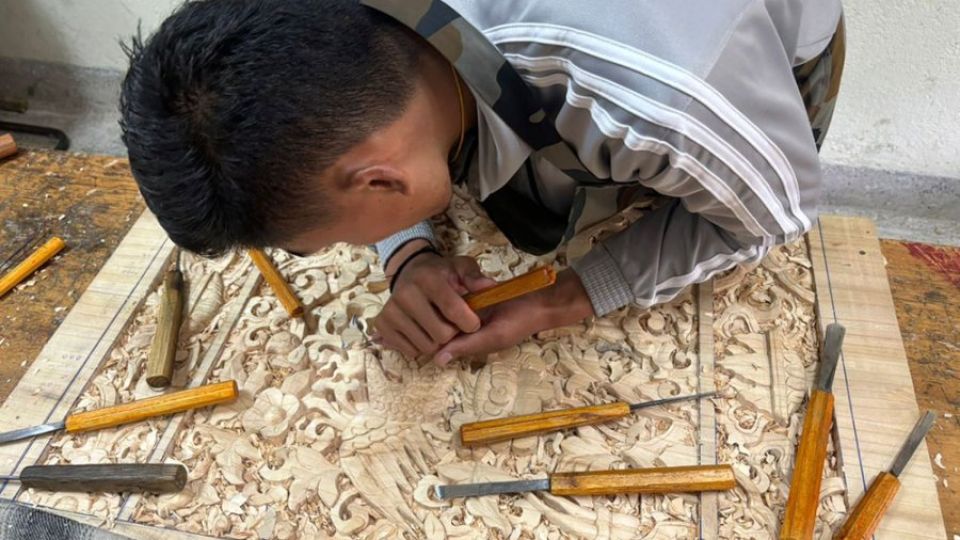September 9, 2024
THIMPHU – The soft hum of focused activity fills the air as 25-year-old Janki Uraon, her eyes fixed on the canvas, deftly strokes her pencil, creating the outlines of her latest creation—a depiction of the Four Friends (Thuenpa Puenzhi)—a traditional artwork that symbolises friendship, cooperation, and harmony.
Janki Uraon joined Wangsel Institute for the Deaf at 22 after attending a Special Education Needs school in Tendu, Samtse.
She faced an uncertain future after her hearing loss progressively worsened, making it increasingly difficult for her to communicate. But her path took a positive turn when she enrolled at Wangsel Institute, where she learned Bhutanese Sign Language (BSL) and found a new calling in painting.
Today, she communicates fluently with her peers, and is, in fact, a top performing student in her painting class.
“I see myself painting for the rest of my life. Painting will support my livelihood,” Janki says.
Her journey reflects the broader mission of Wangsel Institute, which provides Deaf students with an adapted curriculum and vocational training tailored to their needs.
While academics help them communicate through writing with hearing people, vocational training, like painting, is key to their future careers.
At Wangsel, students are introduced to a range of vocational skills, including painting, wood carving, carpentry, and tailoring. The institute has also recently introduced yathra on pangtha weaving, using traditional handlooms.
The institute offers Bhutan Qualification Framework Certificate (BQFC) II courses, similar to the courses provided by the Zorig Chusum Institutes.
Currently, Wangsel Institute is home to 115 students.
The educational model starts with pre-vocational courses in the early grades, transitioning to more intensive vocational training in later years.
Students of classes VII and VIII attend pre-vocational courses for one period. In classes IX and X, students take four periods of vocational courses alongside academics. By classes XI and XII, students can choose a vocational trade for full-time study.
To qualify for academic courses in class XI, students have to score above 75 percent. If students are uninterested in vocational training, they can opt for academics. Currently, there are only two students in class XI who are into academics and none in class XII.
Wangsel Institute’s Principal Dechen Tshering says that Deaf students struggled in academics due to their needs and the limitations of BSL in conveying lessons. “If it takes five minutes to teach a concept to general students, it takes about an hour to convey the same message to Deaf students.”
He said that this is also a reason why the Institute emphasises vocational training as many Deaf students excel in vocational skills and find meaningful career paths.
Despite its success, Wangsel Institute faces challenges. It currently operates under the Ministry of Education and Skills Development (MoESD), alongside general schools, which limits its access to specialised resources.
The Institute has been lobbying to be placed under the Department of Workforce Planning and Skills Development (DWPSD), which is also part of MoESD, and focuses on developing and implementing policies, programmes, and initiatives related to Technical and Vocational Education and Training (TVET) in the country.
“Although the Institute is for the Deaf and requires more resources, the school functions under the same fund as a general school, making it challenging to meet the needs of the students,” Dechen Tshering says. “If the Institute was registered under the DWPSD, we would be able to acquire the necessary support.”
To supplement its funding, Wangsel Institute sells student-made products such as artwork and furniture, reinvesting the proceeds into the school.
The furniture workshop, which operated from a temporary shed since 2018, finally moved into a new, one-storey facility funded by the Asian Development Bank, which opened in May this year.
A new workshop has been a game-changer.
In the workshop, the carpentry students are already working—displaying their vocational skills. With orders pouring in, they are working hard to keep up.
It is the same story for the wood carving and painting groups. Their task? To craft traditional Bhutanese tables.
The wood carvers etch intricate designs into each piece, passing them to the furniture group, who assemble the carved wood into tables. The final group paints the finished products, bringing them to life.
A student in wood carving, Chador Gyeltshen, pauses to reflect. Like his peers, he is optimistic about his future in carpentry and is excited about the possibility of working beyond his village.
“I did on-the-job training at the Royal Academy, and I communicated through writing,” he says, flashing a warm smile.
Wangsel Institute has shaped him into a confident, forward-looking individual. It has given him something his village could not—language and connection, and, sense of purpose.
“Before, I was frustrated, unable to express myself and communicate with others. But here, at Wangsel Institute, we are learning new skills and communication. We can see our future,” Chador Gyeltshen says.


